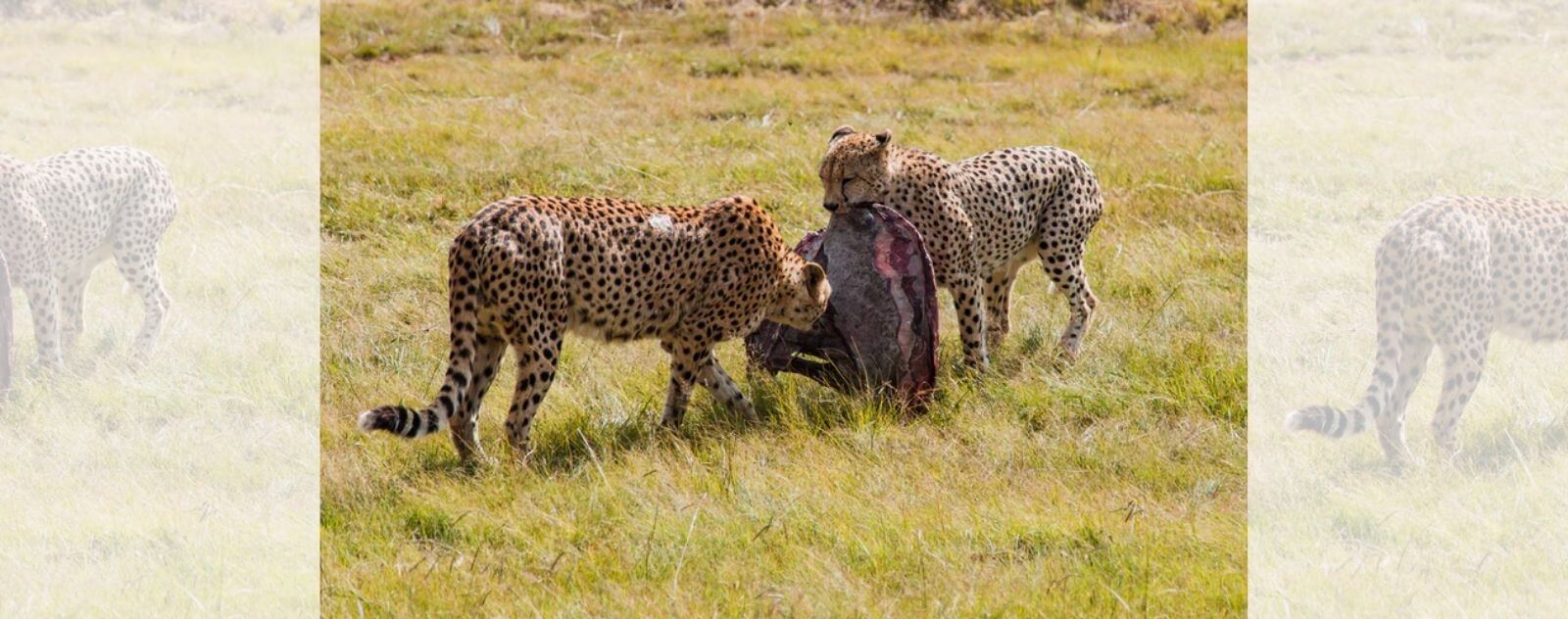
What is the Fastest Land Animal in the World?
of reading - words
Which animal is the fastest in the world? Did you say a cheetah?
You are right and wrong at the same time. It could be a hawk 🦅, a shrimp or even a humble jellyfish. First of all, it depends on the environment in which the animal is moving (land, sea, air) and then, it depends on the type of speed we are talking about.
The animal with the fastest acceleration will not be the same as the one with the highest top speed or even the same as the one that runs the fastest over long distances. We delve deeper into this surprisingly complicated question in the rest of this article and you will quickly find the answer to your question!
1) What is the fastest Animal in the World on Earth?
A- The Fastest Land Animal is not Necessarily the Cheetah
For some reason, the idea that the cheetah is the fastest creature on the planet has actually hardened over years of childhood repetition. But not all the superlatives of the animal kingdom are as easy to adjust as weight (the blue whale 🐳) and size (the giraffe 🦒). Indeed, determining the fastest creature on earth is much more complicated than we have all been led to believe.
"When we talk about how fast something is, it's really not clear whether we're talking about the total duration, the total time it takes to perform the movement, the speed at which it's done, and the acceleration at "which it's done," said Sheila Patek, a biologist and founder of the Patek Lab at Duke University. “Each of these things has a very different meaning .”
For example, cheetahs are only the "fastest animal" if you limit your search to land animals going from point A to point B fairly close by. In this case, of course, cheetahs can reach speeds of 110 kilometers per hour 🛣. The cheetah is the sprint champion !

But even that number requires a bit of context. Cheetahs run for a reason (to catch their dinner) and most prey animals are smart enough not to bet their lives on a sprint. Instead, they zigzag. And that means that while cheetahs are capable of reaching 110 km/h under ideal testing conditions , in the wild they only reach 70 km/h on average and only maintain that speed for one to two seconds. .
B- The Speed of Animals, a Question of Acceleration Speed?
If it's speedup you want, we have a few fast candidates. The praying mantis shrimp , for example, has a spring-loaded, hammer-like appendage that it can cock and discock like a crossbow. Once fired, the mantis shrimp's Mjölnir 🔨 returns home in less than three milliseconds . Translation: You could fit 90 praying mantis shots into the time it takes a human to blink.
Jellyfish boast even faster acceleration. When one of these slimy sacs stings you, it actually launches billions of microscopic venom harpoons into your skin at a speed comparable to that of a bullet fired from a rifle. According to a paper published in Current Biology in 2008, each of these explosive cells, called nematocysts, can discharge in 700 nanoseconds or less and create an acceleration of more than 5 million times the force of gravity, or 5,410,000 grams.

Nematocysts clearly “reign” when it comes to maximum acceleration in the shortest amount of time. But they are marine animals 🌊, when it comes to high acceleration speed in terrestrial environment , trap-jaw ants and termites are the most impressive.
Jawed ants are basically walking bear traps. Their mandibles open 180 degrees and then lock, relying on tiny sensory hairs that act like trip wires and tell the ant when to pull. According to Patek research, these mandibles close at speeds that reach 64 m/s ( ~230 km/h ). Best of all? When the going gets tough, this ant simply aims its weapon at the ground and lets the force of the mandibles ricochet it away from danger. Lift-off !
2) Cheetahs: The Fastest Land Animal in the World (on a sprint)
Cheetahs 🐆 captivate the admiration of many people, with their grace, hunting skills, lightning speed, agility and the face of cute little cheetahs. These cats are amazing.

A- Description and Speed of the Cheetah
The cheetah is the world's fastest land animal over a short distance, capable of reaching speeds of up to 110 km/h . Measuring about 75 centimeters at the shoulder and weighing between 50 to 65 kilograms, they have long, graceful legs, a small rounded head on a long neck, a very flexible spine, a deep chest and special pads on their legs that aid in traction and a long tail which serves to maintain balance at high speed.
The cheetah is also the only cat that cannot retract its claws , giving it more traction . It also has distinctive black "tear marks" that run from the corner of each eye 👀 to the mouth and provide anti-glare protection for daytime hunting.
To summarize, cheetahs are built for speed , grace and hunting .
B- Their dazzling speed: an adaptation for hunting
Cheetahs mainly prey on small antelopes like Thomson's gazelles and impalas, but they also hunt small mammals and birds 🦩. When a cheetah hunts, it gets as close as possible to its prey before trying to outrun it with a burst of speed . The cheetah then uses its paw to drag the animal to the ground, then chokes it by biting it on the neck.

It then eats as quickly as possible while watching for scavengers such as lions, leopards, hyenas, vultures and jackals, which will steal from the very shy cheetah. Unlike most other cats, the cheetah prefers to hunt during the day, especially in the early morning or early evening. Most of the time, cheetahs are solitary animals . Sometimes a male hangs out with a female after mating, but other than that the female is either with her young or alone.
C- The Little Cheetahs: The Cheetahs
The cubs spend a lot of time with their mother as they learn to hunt. The mother brings a small live antelope back to her cubs so they can hunt and catch it. Unfortunately, the calf mortality rate is very high in cheetahs. About 50-75% of them die in the first three months of life, as they are very susceptible to diseases and predators such as eagles, hyenas and lions 🦁.
D- The Threats that Catch the Fastest Animal in the World
Cheetahs are currently classified as "vulnerable" by the IUCN. In 1900, there were an estimated 100,000 cheetahs across Africa. Today, there are approximately 7,500 adults left in the wild ; the population has declined by only about 30% in the last 18 years.

The high calf mortality rate, however, is only one of the problems that cheetahs face; they also face many human-wildlife conflicts and habitat loss 🛺.
Over the years, the cheetah's habitat has shrunk considerably, and it is now only 25% of its original size. Where it lives (mainly in eastern and southern Africa) it tends to be widespread but not abundant. Cheetahs live where their prey is: open plains. However, as human populations grow and people expand agriculture and civilization into the grasslands, an increasingly large portion of cheetah habitat is disappearing .
The other problem cheetahs currently face is human-wildlife conflict. Human expansion into cheetah habitat leads to the disappearance of their usual prey , forcing them to feed on livestock 🐐. Breeders consider them pests and kill them in retaliation.

To help combat these issues, the African Wildlife Foundation works to engage communities and minimize human-wildlife conflict. To help them, animals and Africa's wild lands, you can donate to AWF .
3) The Pronghorn Antelope Can Defeat a Cheetah!
The Pronghorn or Antelope or Pronghorn is one of the most often overlooked mammals on the North American continent 🌎. Usually mislabeled as an antelope, this species of grazer is actually closer to the goats and vast herds that once roamed the plains of America.
The Pronghorn Antelope is the fastest land animal in North America. In fact, it is the second fastest land animal in the world , with only the cheetah reaching higher speeds.

The difference, however, is that while the Cheetah can achieve a faster top speed, it can only sustain it for a few hundred yards. Pronghorn can sustain blazing speeds for miles 🚴 and in the distance it could easily beat a cheetah without shedding a sweat.
A- The Pronghorn is Fast over Long Distances
It can reach a top speed of around 95 km/h and run at a constant speed of 50 km/h for over 30 kilometers! Compared to the other fastest land animal, the cheetah can reach speeds of over 110 km/h but only for sprints of around 700 meters. The Pronghorn could complete a marathon in about 45 minutes , while a human 🏃♀️ would work hard to complete a marathon in over two hours.
This speed starts at a very young age. Females give birth to one or two fawns in the spring, which remain hidden in the grass until they are old enough to escape their main (non-human) predators such as coyotes, bobcats and golden eagles. . This happens in just a few weeks. In fact, a fawn can outrun a human only a few days after its birth .

But if she can so easily leave all of North America's predators in the dust, even at a very young age 👶, how and why did she get so fast?
B- The Fastest Land Animal in North America
According to Stan Lindstedt, a comparator physiologist at Northern Arizona University, there's no secret that this antelope reaches such incredible speeds . “She simply developed the same equipment that all mammals have,” he told Discover Magazine.
“We have discovered that the Pronghorn has an extraordinary ability to process oxygen . Each antelope 🦌 consumes between six and ten liters of oxygen per minute, which is five times more than what a typical mammal would burn. similar size"
So why are they so good at running?
C- The Speed of the Pronghorn Antelope Allows It to Flee Its Predators
After 20 years of wondering about Pronghorn as part of his research, Dr. Byers came up with a compelling theory. Although today there is no more predator capable of catching it during a sprint, this was not always the case. According to Dr Byers, the Pronghorn runs so fast because it is chased by the "ghosts of past predators" - including American cheetahs. Now we see why she can't be beaten by cheetahs only in a sprint.

Dr Byers argues that the Pronghorn honed its running prowess over 10,000 years ago , when the North American continent was still home to fast-moving predators like cheetahs, long-legged hyenas, bear short-faced giant, huge jaguars and saber-toothed cats, and the more familiar, albeit slower, coyotes and wolves.
Predators were much bigger and much faster back then , and thus forced the Pronghorn to evolve to be incredibly fast. Although these predators disappeared, the pronghorn's ability to outrun them persisted.
And now we have a speed wonder that still roams the American prairies, perhaps a relic but still fascinating.

4) The Fastest Land Animals in the World (Table)
The Cheetah and the Pronghorn Antelope are therefore the fastest land animals in the world, but other animals also have a fairly high top speed 🏎 . You can also discover in more detail the TOP 10 fastest animals on the planet .
| Animal | Maximum Speed (in km/h) | |
| 1 | Cheetah | ≃ 115 |
| 2 | Pronghorn Antelope | 95 |
| 3 | Springbok | 88 |
| 4 | Blue Wildebeest or Black-Tailed Wildebeest | 80 |
| 5 | Antelope | 80 |
| 6 | Lion | 80 |
| 7 | Thomson's gazelle | 80 |
| 8 | Greyhound | 80 |
| 9 | european hare | 75 |
| 10 | Elks | 72 |
| 11 | African ostrich | 72 |
| 12 | Lycaon or Hyena Dog | 72 |
| 13 | Coyote | 70 |
| 14 | Tiger | 70 |
| 15 | Elk | 65 |
Now when you are asked what is the fastest land animal in the world, you will be able to answer without problem and without making mistakes. Whether we're talking about a sprint or a marathon, the animal world has its champions. If your little champion likes to play with stuffed animals , you are bound to find what he is looking for in our collection of animal stuffed animals !










